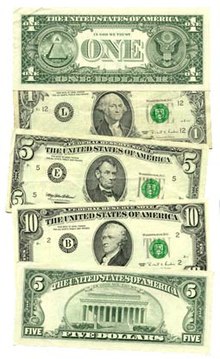The Treasury prints and mints all paper currency and coins in circulation through the Bureau of Engraving and Printing and the United States Mint. ...
Yes, for historic reasons related to the time when the Treasury did decide about the printing of money, the Treasury still is in the chain of command that prints paper currency in circulation. Next in that chain is the Bureau of Engraving and Printing. Finally in the chain that
starts with a decision and orders by the FED, there is an employee of that Bureau who who orders the press crew. If you want to be silly, he is the agent who actually prints the paper money, but only after the FED has authorized it and said how much.
Many years ago, the US Treasure did decide* on how, when, and how much to print. Now, some time after the FED was created, the
treasury has NOTHING to do with those decisions. It is just one of three agents in the chain of command that gets the presses rolling to make the new money the FED ordered made. As for example in QE1 & 2, the treasury is not deciding, ordering new funds be created.
All printing of physical money or the creation of new electronic money it is ordered by the FED, NOT by the Treasury. The FED says when and how much. Specifically it is the Board of Governors of the Federal Reserve System that creates ALL new funds that circulate in the US.
Most of the circulating money is electronic credits now days. For the production of that, the Treasury is not even part of the chain of command the FED's "Print Order" passes thru. The FED just tells some (or all) of its (12, I think) "participating" commercial banks to credit the FED's account in them with X dollars. These are "new deposits" in those banks which like any other money deposited can have up to 90% lent to others. These lent funds usually** end up as deposits in some other bank, which can then lend up to 90% of that deposit to still others so it typically ends up in another bank, etc. with the net final effect that up to 10 times the FED's direct deposit in the first participating bank is added to the M1 money supply. Thus for more than 90% of the creation of new circulating money the Treasury is not even an agent in the chain of command creating new money.
Go ahead adoucette -admit, for the first time ever, that you were wrong. It does not hurt - I have done it.
* Back in the mid and late 1800s, some times it was the congress that decided to create new money. For example they ordered the mint to coin new siliver dollars from all the silver brought to it. The silver producing state's congress people were behind this as they wanted silver dollars to circulate more instead of gold dollars.
Congressman William Jennings Bryan gave a still famous speech which included: "Mankind should not be crucified on a Cross of Gold." - It was one of the most moving speechs ever given in Congress.
Back then the US Treasury normally did print money. (FED did not exist yet.)
That's him on congress men's shoulders. More at:
http://en.wikipedia.org/wiki/Cross_of_Gold_speech
The FED can also increase M1 (when, as now, the Treasury wants/ needs/ to sells bonds that would need higher interest rates than the FED desires). It does this with "thin air money" using its EXCLUSIVE power to create money. (
"Exclusive" as the Treasury can NOT create money.)
I.e. the FED is one of the main buyers of US bonds and paying for those Treasury bonds does put more "thin air money" into circulation.
Again all new money production and even interest rates is controlled by the FED. The Treasury just makes new bonds as needed to pay the US's growing deficits and to "roll" the oldered maturing ones and tries to sell them. They, not the FED, do determine how many of each maturity they make. I.e. The Treasury's job is to manage the US debt, not to make new money.
** Not what often happens today, especially with the Funds the ECB makes from "thin air." Most banks in US and EU are NOT lending the newly created funds. Instead of take some risk for higher interest, they are buying the treasury bonds. Thus, to considerable extent, the FED and the ECB are "pushing on a string" - not able to get their new thin air money into the real economy to stimulate it.
"{European} Commercial banks parked almost half a trillion euros at the European Central Bank, the highest on record, as the mix of debt crisis worries and a recent giant injection of ECB cash left banks awash with money but too scared to lend it. ..." From:
http://www.ibtimes.com/articles/282306/20120116/wary-banks-boost-ecb-deposits-reserve-change-due.htm
I.e. 100% of the ECB's recently injected thin air money had no stimulation effect! For the same reasons, until very recently, QE 1 & 2 had little effect except by buying Treasury bonds, these "scared US banks" did help the FED keep interest rates low.




